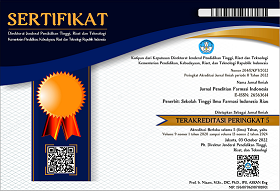AKREDITASI-SINTA-5
Author Guidelines
Before submitting, authors are required to create an account at the JPFI OJS link (Click here to create an account). After having an account, the author can log in to the OJS account and can make submissions (Click here to login to your account). Manuscripts that have been submitted will be reviewed through the OJS system and sent to the author for revision. Please follow the author guidelines and use the template bellow in writing your manuscript.
Template and Systematic Writing
Manuscripts can be written in Indonesian or English with Times New Roman letters are arranged systematically in the following order:
- The title must be informative, specific, and clear, written in capital letters (except the Latin names of plants, bacteria, fungi, etc) (Font size 16).
- The author's name is written under the title, without a bachelor's degree (Font size 10). If there is more than one author, separated by commas and the author's name for correspondence is marked with an asterisk (*) (font size 9), accompanied by the name and address of the institution (affiliation), and corresponding e-mail (font size 8).
- Abstract should be written in Indonesian and English in 200-250 words, with Times New Roman, 8 pt, and 1 space. Abstracts should be clear, descriptive and should provide a brief description of the problem under study. The abstract includes brief reasons for choosing the topic or the importance of the research topic, research methods and a summary of the results. The abstract should end with a comment about the importance of the results or a brief conclusion.
- Keywords (keywords): should describe the contents of the manuscript in its entirety, maximum 5 words, separated by comma, arranged alphabetically (font size 8).
- Introduction contains background research issues, literature review relevant to the problem under study, showing novelty, and objectives (the aim of study) (font size 10).
- Methods contain materials, important tools/instruments used, and procedures, such as techniques of samples or data colection, bioassay procedures, and techniques of data analysis (font size 10).
- Results and Discussions: contains the results of the analysis which is the answer to the problem of research. Sharpness of analysis and synthesis at least includes a description of the findings of the work that discusses sharply, its relevance to previous concepts/theories, critically comparing them with the work of others, and corroborating or correcting previous findings. Avoid repeating the work procedures in this section (font size 10).
- Conclusion (font size 10).
- Acknowledgments (if any) (Font size 8)
- References (Font size 8).
Writing Procedures:
- Manuscript is written on A4 paper with the top margin setting 3 cm, left, right and bottom 2 cm. Manuscripts are written with a distance of 1 space and the total number of manuscripts is a maximum of 10 pages.
- For manuscript type of Article Review, it can be adjusted to these provisions. Literature review is a review article from journals and or books on the latest pharmaceutical sciences.
- The table must be intact, clearly legible and the title of the table at the top is numbered with Arabic numerals (Table 1, 2, 3, etc).
- Images, including graphics, are made separately from the text, the size is between page to 1 page, the title of the image is written below the image with serial numbers in Arabic numerals (Figure 1, 2, 3, etc), and if reproduced, all descriptions must be clearly legible (minimum recommended image resolution is 300 dpi).
- The references are arranged alphabetically (Harvard Style) and recommended using the Mendeley, Zettero or End Note applications and so on. Quotations or citation in the manuscript are indicated by the author's last name, followed by the year (Ikhtiarudin, 2021). If the quote or citation has two author names, between the first and second authors is given “dan", then followed by the year (Ikhtiarudin dan Muhtadi, 2018). If the citation consists of more than two authors, the last name of first author is followed by “et al”., then followed by the year (Ikhtiarudin et al., 2018).
Type of Articles:
- Original article is an article of detailed research that reports original research and is classified as primary literature. Original research paper includes hypotheses, background problems, research methods, results, interpretation of research findings, and discussion of possible implications. This article consist of the Title, Abstract, Keywords, Introduction, Methods, Result and Discussion, Conclusion, Acknowledgement, and References.
- Review Articles should be contain up-to-date information, comprehensively cover relevant literature and preferably be written by scientists who have in-depth knowledge on the topic.
- Case Study is an article compiled by pharmacy practitioners. The written cases are usually those that contribute significantly to the knowledge that is in the field.




